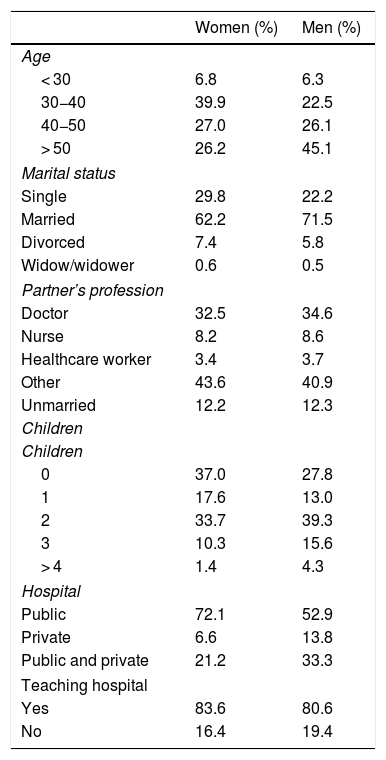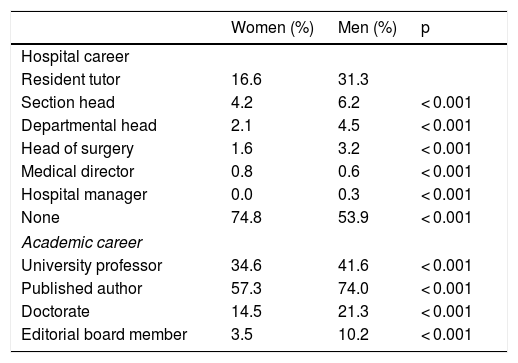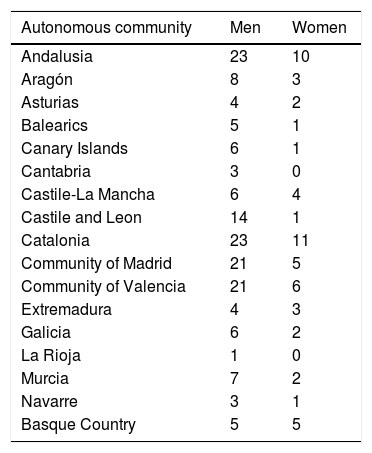Publications of diverse medical specialties confirm that gender differences still exist in the medical field. This particular study aims to investigate whether this problem exists in the specialty of Anaesthesiology in Spain.
MethodsAn anonymous survey was distributed among anaesthesiologists in Spain. It had 39 questions and was designed to investigate professional position, work conditions, personal situation, and individual perceptions. The goal was to target the majority of anaesthesiologists working in Spain.
ResultsCompleted surveys were received from 1619 respondents which represents 17.6% of the total number of anaesthesiologists in Spain; 654 respondents were male (40.4%) and 965 were female (59.6%). The greater differences were found in the following areas: 70.0% of the respondents advised that their head of department is male. When asked about management and leadership positions, 25.2% of female respondents had ever had any management role in contrast to 46.1 % of men (p < 0.001). Regarding academic positions, 10.3% of male respondents are university professors in contrast to only 4.8% of women (p < 0.001). 46.0% of the women surveyed believe that gender discrimination exists in the workplace whereas only 12.6% of men reported the same. A third of women (36.6%) consider their gender a barrier to promotion and fear losing their job due to pregnancy. Furthermore, both genders have witnessed patients and colleagues treating staff differently according to gender.
ConclusionThe results of the survey show the existence of a gender gap among Spanish anaesthesiologists. Of particular note, women are under-represented in academic and leadership positions. Additionally, a considerable percentage of respondents perceive gender-based discrimination to be active in their workplaces. This study could serve as a template for future research in other neighbouring countries and as a means to monitor any changes in coming years.
En la última década se han publicado numerosos trabajos en los que se pone de manifiesto la persistencia de diferencias de género en medicina. La finalidad de este estudio es investigar si este problema existe en la especialidad de Anestesiología en España.
MétodosEl estudio se llevó a cabo mediante una encuesta anónima que se distribuyó entre los especialistas en anestesiología. El cuestionario constaba de 39 preguntas diseñadas para investigar la situación profesional, laboral y personal, así como las percepciones individuales en relación a la discriminación de género en el trabajo.
ResultadosSe incluyeron 1.619 encuestas, lo que representa el 17,6% del total de anestesiólogos de España, 654 participantes fueron hombres (40,4%) y 965 mujeres (59,6%). Las mayores diferencias fueron observadas en las siguientes áreas: el 70,0% de participantes informaron de que su jefe de servicio es un hombre. En relación a los puestos de liderazgo, el 25,2% de las mujeres que respondieron a la encuesta habían desempeñado algún puesto de confianza frente al 46,1% de los hombres (p < 0001). En cuanto a la posición académica, el 10,3 % de los hombres respondieron ser profesores de universidad en contraste al 4,8% de mujeres (p < 0001). El 46,0% de las mujeres que participaron en la encuesta piensan que existe discriminación de género en su profesión, mientras que sólo el 12,6% de los hombres lo reconocieron. Un tercio de las mujeres (36,6 %) consideran su condición de género una barrera para promocionar y tienen miedo de perder su trabajo por quedarse embarazadas. Además, tanto hombres como mujeres han presenciado un trato diferente por parte de pacientes y personal sanitario hacia sus compañeras anestesiólogas.
ConclusiónLos resultados de esta encuesta demuestran que existe una brecha de género en Anestesiología en España. En concreto, las mujeres están poco representadas en puestos académicos y de liderazgo, y un porcentaje considerable de encuestados perciben diferencias de género en el trabajo. Este estudio puede servir para monitorizar futuros cambios en nuestro país y como ejemplo para investigaciones en otros países vecinos.












